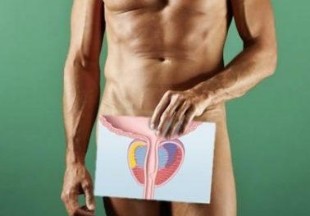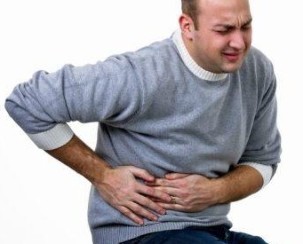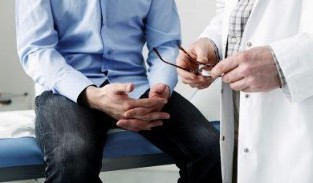The inflammation of the prostate is a serious disease that can lead to serious consequences if not treated. The prostate is located below the bladder.
When it is inflamed, it increases significantly in size, blocking the neck of the bladder and obstruct the flow of urine. Therefore, when the first symptoms and manifestations, you should immediately consult a specialist, to identify and begin treatment of prostatitis.

The main symptoms: how to manifest the prostatitis?
Previously, it was thought that this disease of adults and the elderly, men, but in the conditions of life (environment, quality of the food, the fashion, the negligence and the attitude of young people to their health, continues to circulate in the car, etc) inflammation of the prostate is much more "rejuvenated".
The national institute of young people under the age of 18 years is 5%, between the ages of 18 to 30 years old – 45%, from 30 to 50 years, 20% of people over 50 years old – 30%. He says that to follow the male to the health and to the listening of symptoms, you need to at a young age.
There are several types of prostatitis on the form of the event (chronic, acute) and the spirit of the inflammation (bacterial, stagnant, festering, infection control, calculous). The symptoms of the disease is variable, depending on the type of inflammation of the prostate gland in men.
The symptoms of the prostatitis:
- poor health (malaise, chills, fever). The man can begin to throw hot, cold. General symptoms are similar to the manifestation of the SARS, or the flu;
- a sharp increase in body temperature, low grade brand (37,5-38° c) above;
- the cutting forces, the stabbing pain in the perineum (the area of the groin, anus, etc);
- the pain in the lower back, the hips, giving your feet, the knees, the feet or the leg muscles;
- acute pain appearing the act of defecation, and so tender;
- the urination problems (lack / frequent need to urinate, pain or difficulty passing urine). Retention of urine long period of time (over 12 hours);
- the deterioration of sexual function (the weakness or total absence of erection, ejaculation, problems of design);
- the allocation of the genital organs (in more severe cases of prostatitis).
The symptoms of chronic prostatitis:
- urinary tract problems (difficulty to urinate, the pain, the lack of discharge of urine, feeling of incomplete evacuation of the bladder, etc);
- unpleasant pulling on the pain and sensations in the perineum, between the feet, the groin and the anus. The pain syndrome is not pronounced;
- in the groin can sometimes produce a sharp pain or a sensation of strong burning sensation, passing crotch;
- discomfort during a long period of time (sleepiness, apathy, depression, constant fatigue, muscle weakness, etc);
- nervousness, irritability;
- a slight increase of the temperature of the body. Sometimes, the long period of time can take a low-grade fever;
- a decrease of the sexual function (erection problems, a decrease in or absence of ejaculation, decreased libido, infertility, etc).

Chronic prostatitis involves periods such as in the remission and relapse. In the period of recurrence of chronic symptoms can develop in the symptoms of the acute form of the disease.
The symptoms of a bacterial infection of the form:
- signs of inflammation (heat, fever, fever, fatigue, pain syndrome in the muscles and bones);
- the local signs of inflammation of the prostate gland (syndrome of pain in the perineum, groin, anus);
- problematic urination;
- to change the consistency, color and smell of the liquids (urine, the secret of the prostate gland, semen, blood).
The symptoms of the calculous of the form:
- weak and moderate pain syndrome in the lower back, sacral department, the perineum, the anus;
- pulling pain and a burning sensation in the perineum, the groin;
- the pain is greatly amplified after sexual intercourse and during active movement;
- problems of micturition, abdominal distension of the bladder;
- decreased libido, problems with ejaculation and erection (up to erectile dysfunction);
- in advanced cases, the sperm may appear from the drops of blood (it becomes clear, pink or red).
The symptoms of the failure of the form:
- standing unpleasant sensations in the groin area, the perineum and the anus;
- periodic dragging pain in the area of the perineum;
- the problem of urination, the feeling is not up to the end of inanis of the bladder;
- the constant increase of the temperature to the low-grade bearings;
- the overall manifestation of the inflammatory process in the body (increase of the SEDIMENTATION rate of erythrocytes in the blood, nausea, drowsiness, fatigue, headache, weakness, muscle pain, etc);
- problems in the sexual sphere (the weakness of the ejaculation and the erection, sterility);
- nervous condition, depression, apathy.
The symptoms of the infectious form:
- the signs of inflammation in the body (increase of the value of the speed of SEDIMENTATION of erythrocytes in the blood of men, muscle pain, increased body temperature);
- a stabbing pain in the lower back, the groin and the perineum;
- the pain during defecation;
- a sharp pain in the groin and the perineum;
- problems with urination (difficulty, increased urination, lack of recommend, etc).
The symptoms purulent of the form:
- the strong the strong increase in body temperature (above 38, 5°);
- signs of inflammation in the body (the highest value of the erythrocyte SEDIMENTATION rate, muscle pain, fever, chills, etc);
- clearly expressed pain syndrome in the groin, the perineum and the anus;
- a sharp pain in the perineum;
- difficulty urinating, painful urination;
- purulent genitalia.
What are the first signs in men?
At the start of a inflammation of the prostate gland in men can occur as a part of the symptoms of the disease. The signs beginning with an inflammation of the prostate, and that it is necessary to pay particular attention:

- an unpleasant sensation in the perineum;
- periodic low-pulling pain in the groin and the perineum;
- pulling an unpleasant sensation in the anus and rectum during defecation (in the absence of a hemorrhoids);
- long discomfort, is not associated with the SARS, sore throat, the flu and other colds;
- decreased libido, blockages in the ejaculation and erection (periodic absence);
- the decline in the quality of orgasm;
- an unpleasant sensation in the urethra and in the groin to sex or after sex;
- the modification of the consistency, color and smell of semen.
- the increase of the temperature of the body.
Expressed by the signs of a prostatitis-acute:
- an increase in temperature up to 37,5-40 degrees, for no apparent reason (not cold, not the flu, is not of the angina of chest);
- the frequency of urination increases up to 3-4 times, and is accompanied by severe pain. The urine flows slowly and with low pressure;
- a burning sensation in the groin, the perineum, and defecation. The pain in the intestine during the act of defecation;
- the allocation of pus from the bowel or the urethra (in a course and a purulent form of the disease).
Expressed by signs of a chronic inflammation of the prostate gland:
- a burning sensation in the groin and the perineum. Burning Sensation in the genitals (especially during urination and sex);
- a purulent discharge from the urethra after urination and tender (active movement or defecation). A purulent discharge from the rectum;
- nervousness, depression, irritability;
- fatigue for no apparent reason, drowsiness.
The syndrome of pain during inflammation of the prostate
Almost always when the inflammation of the prostate, the man himself can be found on the causes of the pain in his nature. The feature of tension, pain or a sharp pain appear in the fork and the groin. When the acute form or during a relapse of a chronic form of the disease of the pain are characterized at once poignant, hard, powerful pain, the cutting and traction. When the chronic form of the disease the pain is intermittent, undulating nature. Also the pain syndrome may be low, but constant. Painful prostate exerts pressure on the urethra, the neck of the bladder and ureters. It is through these channels the urine out of the bladder, can appear pain during urination. Also pain during urination can be a sign of infections of the bladder or urinary system (sexually transmitted diseases STDS).
Accompanying the pain may have another cause. Also that the presence of several officials of the prostate, the pain can not be inflammation of the prostate, and all other diseases.
Other reasons cover the pain:
- the abdominal pain is a symptom of many other diseases. A striking example is appendicitis, acute poisoning, an infection of the gut or the interfaith.
- The kidneys can be sick because of the hernia, degenerative disc disease, pinching of nerve endings, osteoporosis, multiple sclerosis and other diseases of the spine.
- the pain in the anus may occur due to hemorrhoids, fissures, bruising, long seats uncomfortable, a solid surface and a variety of institute (benign or malignant).
- The syndrome of sacral pain of the spine is more serious. Most often this is the problem with the bones, the vertebrae and discs (osteochondrosis, osteoporosis, displacement, tail, etc).

Sometimes, even the pain in the sacrum mean problems with other domestic bodies (the kidneys, intestines, bladder, and ureters), gynecological diseases, thrombophlebitis, an inflammation of the pelvic organs.
- The pain of the feet may signify a manifestation of flat feet, thrombophlebitis, atherosclerosis, varicose veins, arthritis, osteoporosis, inflammation of the sciatic nerve and even diabetes. The pain in the legs can be from many different causes.
The most frequent of which is fatigue of the legs and muscles of long duration of physical exercise.
What is the specialist deals with the treatment of the disease?
Diagnose the patient, the inflammation of the prostate can only a qualified medical practitioner urologist. He collects history and performs examination of the patient. And then directed the man on the analyses (PSA antigen is a protein for the detection of prostatitis) and a pelvic ULTRASOUND.
Also the patient is mandatory rents general analyses of blood and urine. According to the results of all the tests, the urologist can accurately define the diagnosis and the form of the inflammation of the prostate. Only after these procedures, the doctor may prescribe the patient a course of treatment, including medications, antibiotics, and other drugs that usually take home.
A man in 95% of cases, knows exactly what kind of diagnosis will make him a urologist who m', because the pain of the inflammation of the prostate very specific. You have to constantly listen to your body, keep track of all the changes that occur to the body. Only in this way, the man can last for years to maintain men's health. Launched prostatitis threatens not just a disorder of urination, problems with libido, ejaculation, erection, which can eventually lead to infertility.

























